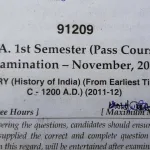Studying economics in the first semester of BA LLB helps students understand foundational principles that connect law and economics. This combination enhances critical thinking and prepares students for future challenges in their legal careers. Below are example questions and answers to aid learning and exam preparation.
Microeconomics
Question
What is microeconomics?
Answer
Microeconomics is the study of individual economic units, such as consumers and businesses, and how they make decisions regarding resource allocation and pricing.
Question
Explain the law of demand.
Answer
The law of demand states that, ceteris paribus, as the price of a good decreases, its demand increases, and vice versa.
Question
Define elasticity of demand.
Answer
Elasticity of demand measures the responsiveness of quantity demanded to changes in price, income, or other factors.
Question
What is the significance of opportunity cost?
Answer
Opportunity cost represents the value of the next best alternative foregone when making a decision.
Question
Explain the concept of marginal utility.
Answer
Marginal utility refers to the additional satisfaction a consumer derives from consuming one more unit of a good or service.
Question
What is meant by perfect competition?
Answer
Perfect competition is a market structure where numerous small firms compete, no single firm influences prices, and products are homogeneous.
Question
How does a monopoly differ from perfect competition?
Answer
A monopoly is a market with one seller dominating, while perfect competition involves many sellers with no control over prices.
Question
Define supply and its determinants.
Answer
Supply is the quantity of a good or service that producers are willing to sell at a given price. Its determinants include production costs, technology, and taxes.
Question
What is consumer surplus?
Answer
Consumer surplus is the difference between what consumers are willing to pay and what they actually pay for a good or service.
Question
Explain producer surplus.
Answer
Producer surplus is the difference between the price producers receive for a good and the minimum price they are willing to accept.
Question
What is the production possibility frontier?
Answer
The production possibility frontier is a curve illustrating the maximum output combinations of two goods that an economy can produce using available resources efficiently.
Question
What is the principle of diminishing returns?
Answer
The principle of diminishing returns states that adding more of one input, while keeping others constant, will eventually lead to smaller increases in output.
Question
Define market equilibrium.
Answer
Market equilibrium is a state where the quantity demanded equals the quantity supplied, leading to a stable market price.
Question
What are public goods?
Answer
Public goods are non-excludable and non-rivalrous goods, meaning everyone can use them without reducing their availability to others.
Question
What is the difference between fixed and variable costs?
Answer
Fixed costs do not change with output levels, while variable costs vary depending on production.
Question
What is price discrimination?
Answer
Price discrimination occurs when a seller charges different prices to different customers for the same product, based on their willingness to pay.
Question
Explain externalities in economics.
Answer
Externalities are the positive or negative effects of an economic activity on third parties who are not directly involved in the activity.
Question
What is meant by utility maximization?
Answer
Utility maximization is the process by which consumers allocate resources to maximize their satisfaction.
Question
What is the role of government in correcting market failures?
Answer
Governments intervene through taxes, subsidies, and regulations to correct inefficiencies and promote equity in markets.
Macroeconomics
Question
What is macroeconomics?
Answer
Macroeconomics is the study of an economy as a whole, focusing on aggregate indicators such as GDP, unemployment, and inflation.
Question
Define gross domestic product (GDP).
Answer
GDP measures the total monetary value of all finished goods and services produced within a country in a specific period.
Question
What are the components of GDP?
Answer
GDP includes consumption, investment, government spending, and net exports (exports minus imports).
Question
What is inflation?
Answer
Inflation is the sustained increase in the general price level of goods and services over time.
Question
Explain monetary policy.
Answer
Monetary policy involves central bank actions to control money supply and interest rates to achieve economic stability.
Question
What is fiscal policy?
Answer
Fiscal policy refers to government spending and tax policies aimed at influencing economic activity.
Question
Define unemployment.
Answer
Unemployment is the state where individuals who are capable of working and seeking jobs cannot find employment.
Question
What is the business cycle?
Answer
The business cycle refers to the periodic fluctuations in economic activity, including expansion, peak, contraction, and trough.
Question
What are trade deficits and trade surpluses?
Answer
A trade deficit occurs when a country’s imports exceed its exports, while a trade surplus occurs when exports exceed imports.
Question
Explain the concept of economic growth.
Answer
Economic growth is the increase in the capacity of an economy to produce goods and services over time.
Question
What is aggregate demand?
Answer
Aggregate demand is the total demand for goods and services in an economy at a given price level and time period.
Question
What is aggregate supply?
Answer
Aggregate supply is the total output of goods and services that firms are willing to produce at a given price level and time.
Question
What are automatic stabilizers in economics?
Answer
Automatic stabilizers are mechanisms like taxes and welfare that adjust automatically to counteract economic fluctuations.
Question
What is the role of the International Monetary Fund (IMF)?
Answer
The IMF provides financial support and policy advice to member countries to promote global monetary cooperation and stability.
Question
What is deflation?
Answer
Deflation is the decrease in the general price level of goods and services, often leading to reduced economic activity.
Question
What is the Phillips curve?
Answer
The Phillips curve illustrates the inverse relationship between unemployment and inflation in the short run.
Question
Explain the term “hyperinflation.”
Answer
Hyperinflation is an extremely rapid and uncontrollable rise in prices, often caused by excessive money supply.
Question
What is stagflation?
Answer
Stagflation is a situation where an economy experiences stagnant growth, high unemployment, and high inflation simultaneously.
Question
What is the difference between nominal and real GDP?
Answer
Nominal GDP is measured in current prices, while real GDP is adjusted for inflation to reflect constant prices.
Question
What are leading economic indicators?
Answer
Leading economic indicators predict future economic activity and include metrics like stock market performance and new housing starts.
Understanding economics in BA LLB 1st Semester is essential for grasping the complex interplay between law and economic policies. These questions and answers provide foundational knowledge to enhance academic and practical learning. Students should explore various topics thoroughly to excel in their studies.
Latest Posts
- Step-by-step guide to download and apply for jee mains admit card 202
- Comprehensive 2025 government holidays and recruitment details for job seekers
- JEE Mains Admit Card 2025: Your Step-by-Step Guide to Downloading the Hall Ticket
- Everything You Need to Know About 2025 Government Holidays Recruitment
- Comprehensive Guide to rrb d group recruitment 2025 – Eligibility, Vacancies, and Application
- Detailed guide to nps trust recruitment 2025 vacancies, eligibility and apply process
- Comprehensive guide to hpcl recruitment 2025 notification, vacancies, and application process
- ignou bed admission 2025 complete recruitment guide with eligibility and process
- Comprehensive Guide to Indian Army Agniveer Recruitment 2025 Notification and Jobs
- Everything You Must Know About CBSE Board Exams 2025 Changes & New Rules






